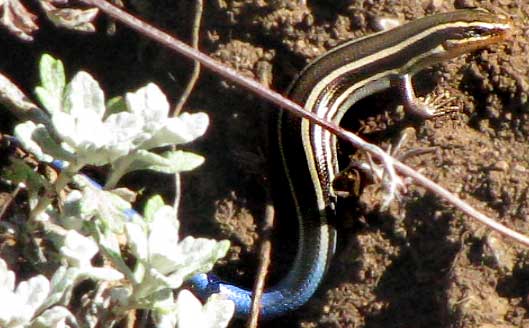Excerpts from Jim Conrad's
Naturalist Newsletter
from the July 19, 2009 Newsletter, issued from the Siskiyou Mountains west of Grants Pass, Oregon:
SKINK AT LAST
Already back in April when late afternoon sunlight warmed a nearby roadcut I began seeing a certain blue-tailed skink. He was a lot like the East's Five-lined Skink, but thicker and stubbier, with broader white lines. I've never had problems approaching Five-liners so I figured snapping a picture of this western species would be easy.
The skink lived in a neat tunnel about as broad as my little finger, in the roadcut's almost-vertical dirt face. One sunny afternoon I set my camera on a tripod pointing at the hole and waited. In about 20 minutes he came out and paused right beside his hole. Either the tiny movement of my finger on the shutter or the sound of the camera's motor grinding as it autofocused sent the skink rushing into his hole, yielding a blurred picture. That was when I realized that if I were to get this critter's picture I'd need some luck.
This week it finally happened. I spotted a blue tail poking from behind a bush while that same bush blocked the skink's view of me. I pulled out the camera and waited. The resulting shot, showing a Western Skink, EUMECES SKILTONIANUS*, emerging from behind the bush is below:

In this part of the world there's only one skink species with a blue tail, so identifying it was pretty easy. Western Skinks are fairly common on dry slopes, especially south-facing roadcuts. The field guide says that the tail usually is gray or brown with only juveniles having bright blue ones. I've only seen blue-tailed ones so that's something to figure out.
Western Skinks feed mostly on insects, spiders and earthworms, and are distributed from southern British Columbia into Mexico's Baja California, east to central Utah.